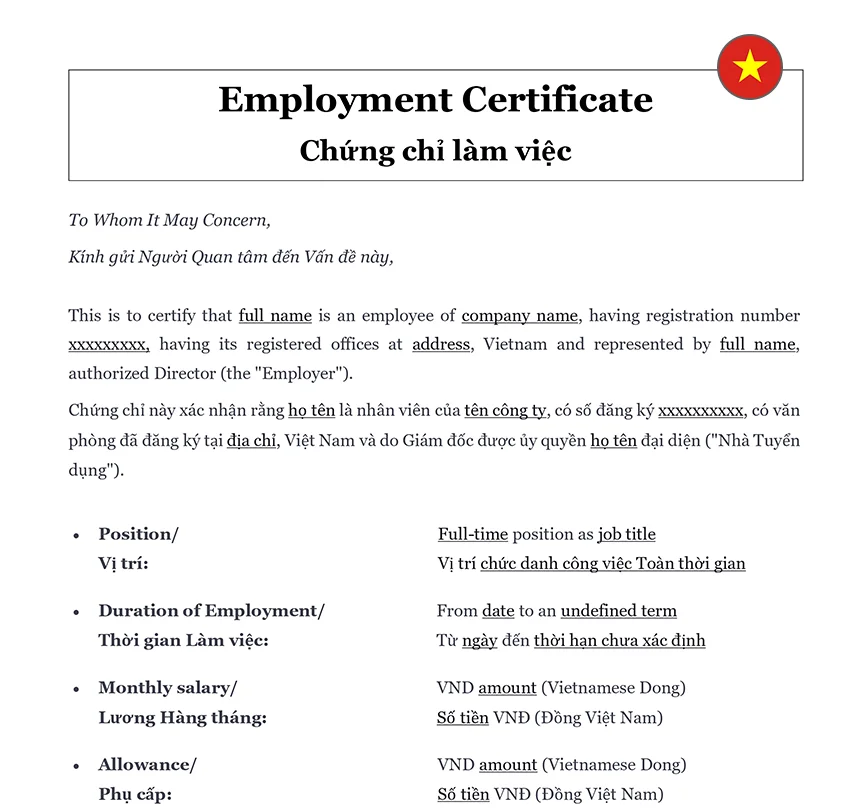Understanding Work Certificates
Work certificates are essential documents that serve multiple purposes, from verifying employment history to aiding in new job applications. They provide a detailed account of an employee’s tenure, responsibilities, and achievements within a company. This document is a formal acknowledgment of an employee’s time with an organization and can be critical for future job opportunities, background checks, or even higher education applications. Ensuring that the work certificate is thorough and accurate can greatly benefit the employee while also reflecting the employer’s professionalism and attention to detail. Use our Employment Certificate template for formal employee documentation.
Legal Requirements for Issuing Work Certificates
Understanding the legal requirements for issuing work certificates is essential for compliance and avoiding potential disputes. Employers in Vietnam must adhere to the following guidelines:
1. Obligation to Issue Work Certificates: According to the Labor Code of Vietnam, employers are required to issue a work certificate upon the termination of an employment contract. This requirement is crucial to ensure that employees have formal documentation of their employment history.
2. Content of the Certificate: The work certificate must include the employee’s job title, duration of employment, and a summary of job performance. This information provides a comprehensive overview of the employee’s role and achievements during their tenure.
3. Legal Repercussions: Failure to provide a work certificate can lead to legal consequences for the employer. It is important to fulfill this obligation to avoid potential disputes or claims from former employees.
4. Compliance and Transparency: Adhering to these requirements not only ensures compliance with Vietnamese labor laws but also fosters goodwill and transparency between employers and employees. Proper documentation reflects positively on the company’s professionalism and legal adherence.
ℹ️ An Employment Termination Letter may precede this process, and it’s crucial that the work certificate reflects any terms agreed upon in this document.
Importance of Employment Certificates
Recognizing the importance of employment certificates can significantly impact an employee’s career advancement and job applications. Consider the following:
1. Proof of Employment
An employment certificate serves as formal proof of employment, which is often required for new job applications, promotions, or loan applications. It validates the employee’s professional history and role within the company.
2. Career Progression
A well-drafted employment certificate can enhance an employee’s credibility and make them a more attractive candidate to potential employers. It showcases their skills, responsibilities, and contributions, influencing career progression.
3. Professional Record
This document provides a formal record of the employee’s achievements and responsibilities. It is crucial for career development and personal growth, as it highlights their professional accomplishments.
ℹ️ Learn from Reviewing Employee Performance in Vietnam for integrating work certificates into performance management.
Key Information to Include in Work Certificates
| ➤ Employee's Full Name: As per official records, ensuring correct spelling and completeness. |
| ➤ Job Title: The exact position held by the employee, including any changes during their tenure. |
| ➤ Employment Duration: Start and end dates of employment, reflecting the total period of association. |
| ➤ Job Responsibilities: A detailed summary of the key responsibilities and tasks handled by the employee, showcasing their contributions. |
| ➤ Performance Evaluation: An objective evaluation of the employee's job performance, highlighting strengths and any notable achievements. |
| ➤ Reason for Leaving: If applicable, the reason for termination or resignation, presented professionally and factually. |











